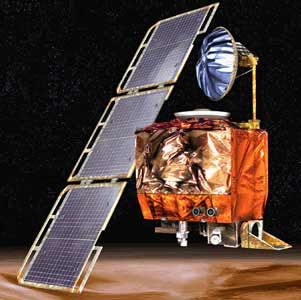
Home - Search - Browse - Alphabetic Index: 0- 1- 2- 3- 4- 5- 6- 7- 8- 9
A- B- C- D- E- F- G- H- I- J- K- L- M- N- O- P- Q- R- S- T- U- V- W- X- Y- Z
MCO
 Mars Climate Orbiter Credit: Manufacturer Image |
AKA: Mars Climate Orbiter. Status: Operational 1998. First Launch: 1998-12-11. Last Launch: 1998-12-11. Number: 1 . Thrust: 637 N (143 lbf). Gross mass: 629 kg (1,386 lb). Unfuelled mass: 338 kg (745 lb).
The Mars Climate Orbiter was the second flight of the Mars Surveyor Program. Primary propulsion was a 65 kgf Leros bipropellant engine. Mars Climate Orbiter was equipped with a MARCI color imager for mapping and weather studies; a PMIRR radiometer; and a UHF communications system which would also relay data from the Mars Polar Lander, scheduled for launch in January 1999. Mars Climate Orbiter was to enter a 160 km x 38600 km polar orbit around Mars on September 23,1999, and use aerobraking to reach a 373 km x 437 km x 92.9 degree sun-synchronous mapping orbit by November 23 1999. The science mission was to map the Martian surface at high resolution, and study the distribution of water vapor and ozone. It would study the transport of dust and water with latitude, the motions of weather systems and dust storms, and study the response to daily solar heating.
| Mars Climate Orbiter (MCO) Null |
Family: Mars orbiter. Country: USA. Launch Vehicles: Thor, Delta, Mars tactical rocket, Delta 7425-9.5. Projects: Mars, Mars Surveyor. Launch Sites: Cape Canaveral, Cape Canaveral LC17A. Agency: NASA, Martin. Bibliography: 2, 3908, 3909.
1998 December 11 - . 18:45 GMT - . Launch Site: Cape Canaveral. Launch Complex: Cape Canaveral LC17A. Launch Pad: SLC17A. LV Family: Thor. Launch Vehicle: Delta 7425-9.5.
- Mars Climate Orbiter - .
Mass: 629 kg (1,386 lb). Nation: USA.
Agency: JPL.
Manufacturer: Martin.
Program: Mars Surveyor.
Class: Mars.
Type: Mars probe. Spacecraft: MCO.
Decay Date: 1999-09-23 . USAF Sat Cat: 25571 . COSPAR: 1998-073A.
The Mars Climate Orbiter was the second flight of the Mars Surveyor Program. The probe was to enter a 160 km x 38600 km polar orbit around Mars on September 23,1999, and use aerobraking to reach a 373 km x 437 km x 92.9 degree sun-synchronous mapping orbit by November 23 1999. While the Mars Orbit Insertion burn began as planned on September 23, 1999 at 08:50 GMT, no signal was received after the spacecraft went behind the planet. Subsequent investigation showed that the spacecraft had plunged deep into the Martian atmosphere, with its closest approach to Mars being 57 km. It was concluded that the spacecraft burnt up in the atmosphere. It was later found that cutbacks in tracking, combined with incorrect values in a look-up table imbedded deep in the spacecraft software (use of pounds force instead of newtons) were to blame. This failure led to a shake-up of NASA's 'faster, better, cheaper' approach to unmanned spaceflight. Additional Details: here....
Back to top of page
Home - Search - Browse - Alphabetic Index: 0- 1- 2- 3- 4- 5- 6- 7- 8- 9
A- B- C- D- E- F- G- H- I- J- K- L- M- N- O- P- Q- R- S- T- U- V- W- X- Y- Z
© 1997-2019 Mark Wade - Contact
© / Conditions for Use